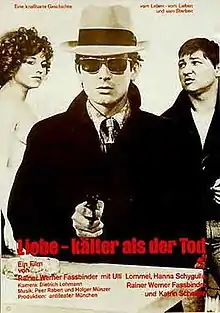Love Is Colder Than Death (film)
Love is Colder Than Death (German: Liebe ist kälter als der Tod) is a 1969 West German black-and-white film directed by Rainer Werner Fassbinder, his first feature film. In the original theater presentation in Berlin the title was first Kälter als der Tod; at the beginning of film production, it was Liebe – kälter als der Tod as on some film posters. The cinematographer Dietrich Lohmann and the cast as an ensemble won an award at the German Film Awards in 1970.
| Love Is Colder Than Death | |
|---|---|
 Theatrical release poster | |
| Directed by | Rainer Werner Fassbinder |
| Written by | Rainer Werner Fassbinder |
| Produced by |
|
| Starring |
|
| Cinematography | Dietrich Lohmann |
| Music by |
|
Release date | 26 June 1969 (Berlin International Film Festival) |
Running time | 88 minutes |
| Country | West Germany |
| Language | German |
| Budget | DEM 95,000 |
Plot
Franz (Reiner Werner Fassbinder) encountered our cold and silent protagonist Bruno (Ulli Lommel) when the Syndicate adopted every possible mean to force and reason things out for them. The two did compromise and never reached an agreement with the organization. Left with no choice, the interrogator (Peter Moland) had to let them go. Before bidding farewell, Franz informed Bruno the address of his apartment in Munich, paving the way for the ensuing events of the plot.
Petty hood Franz (Fassbinder) refuses to join the syndicate, where he meets a handsome young thug called Bruno (Lommel) and gives him his address in Munich. It is the flat of the prostitute Joanna (Schygulla), where Franz lives as her pimp. Bruno has been ordered by the syndicate to follow Franz and on going to the address is told he has moved. So he goes round the streets of the city asking prostitutes if they know a prostitute called Joanna.
Eventually he finds where the pair are hiding, because Franz is being sought by a Turk for killing his brother. Bruno offers to solve the problem, so the three go to the café where the Turk can be found and shoot him. As they leave, Bruno also shoots the waitress who is the only witness. Franz is picked up by the police for both killings and, while he is held for questioning, Joanna starts an affair with Bruno.
When Franz is freed because the police have no evidence, the three then plan a bank robbery. As they arrive outside, plainclothes police appear and Bruno is killed in a shootout while Franz and Joanna get away. In the car she tells him she had tipped the cops off about the robbery. He says "Nutte" [whore] and keeps on driving as the film fades to white.[1][2][3]
Cast
- Ulli Lommel – Bruno
- Rainer Werner Fassbinder – Franz
- Hanna Schygulla – Joanna
- Katrin Schaake – Woman on train
- Liz Soellner – Newspaper Saleswoman
- Gisela Otto – Prostitute
- Ursula Strätz – Prostitute
- Monika Stadler – Waitress
- Hans Hirschmüller – Peter
- Les Olvides – Georges
- Peer Raben – Jürgen
- Howard Gaines – Raoul
- Peter Moland – Interrogator
- Kurt Raab – Department Store Detective
- Peter Berling – Weapons Seller
- Anastassios Karalas – Turkish Man
Reception
Initial reception was generally negative, and the film was even booed at the 19th Berlin International Film Festival in 1969.[4] Today, however, it is seen as a fine example of Fassbinder's early style, with a heavy 'nouvelle vague' influence.
The film is dedicated to "Claude Chabrol, Éric Rohmer, Jean-Marie Straub, Linio, and Cuncho". The last two refer to the main characters in Damiano Damiani's 1966 film A Bullet for the General. Ulli Lommel's styling (and also the poster artwork) is inspired by Alain Delon in Le Samouraï.
References
- Thomas Elsaesser, Fassbinder's Germany: History, Identity, Subject (Amsterdam University Press, 1996; ISBN 9053560599), p. 267.
- Wallace Steadman Watson, Understanding Rainer Werner Fassbinder: Film as Private and Public Art (Univ. of South Carolina Press, 1996; ISBN 1570030790), p. 69.
- Laurence Kardish (ed.), Rainer Werner Fassbinder (Museum of Modern Art, 1997; ISBN 0870701096), p. 42.
- "Rainer Werner Fassbinder". Cinematheque.bc.ca. Archived from the original on 2006-08-26.